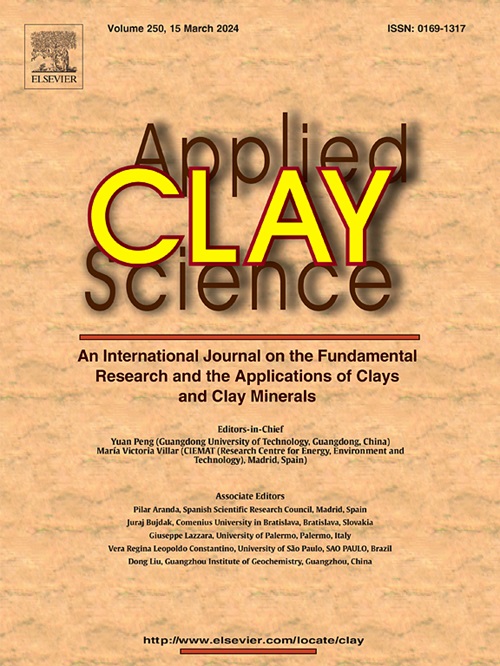辣木-银纳米颗粒-高岭石纳米复合材料的制备、表征及抗菌活性研究
IF 5.3
2区 地球科学
Q2 CHEMISTRY, PHYSICAL
引用次数: 0
摘要
尽管在利用辣木叶提取物合成纳米银颗粒(AgNPs)的各种应用方面进行了广泛的研究,但将辣木合成的AgNPs固定在高岭石载体上的合成和抗菌效果仍未得到探索。本研究介绍了一种新型辣木(Mo)-银纳米颗粒(AgNP)-高岭石纳米复合材料(Mo- ag - kao)的绿色合成配方。将生物合成的AgNPs掺入高岭石中制备纳米复合材料,以提高其稳定性和抗菌效果。利用x射线衍射(XRD)、场发射扫描电子显微镜(FESEM)、能量色散x射线能谱(EDX)、透射电子显微镜(TEM)、热重-差热分析(TGA-DTA)和zeta势分析等多种分析技术对纳米复合材料进行了表征。表征结果表明,利用油橄榄提取物合成的球形AgNPs成功地结合到高岭石上,平均粒径为20 nm。此外,Mo-Ag-Kao纳米复合材料中仍保留了高岭石结构,并表现出较高的热稳定性(高达700℃)。该纳米复合材料对广泛的细菌菌株具有很强的抗菌性能,包括革兰氏阳性金黄色葡萄球菌和革兰氏阴性大肠杆菌。综上所述,使用高岭石作为AgNPs的载体不仅可以防止纳米颗粒聚集,还可以提高其抗菌效果。本文章由计算机程序翻译,如有差异,请以英文原文为准。
Preparation, characterization, and antibacterial activity of Moringa oleifera‑silver nanoparticles-kaolinite nanocomposite
Although extensive research has been conducted on the synthesis of silver nanoparticles (AgNPs) using Moringa oleifera leaf extract for various applications, the synthesis and antibacterial efficacy of M. oleifera-synthesized AgNPs immobilized onto a kaolinite carrier remains unexplored. This study introduces the formulation of a novel Moringa oleifera (Mo)-Silver Nanoparticle (AgNP)-Kaolinite nanocomposite (Mo-Ag-Kao) synthesized through the green method. The nanocomposite was developed by incorporating biosynthesized AgNPs into kaolinite to enhance its stability and antimicrobial efficacy. The nanocomposite was characterized using various analytical techniques, including X-ray diffraction (XRD), field emission scanning electron microscopy (FESEM), energy dispersive X-ray spectroscopy (EDX), transmission electron microscopy (TEM), thermogravimetric-differential thermal analysis (TGA-DTA), and zeta potential analysis. The characterization results revealed the successful incorporation of spherical AgNPs that were synthesized using M. oleifera extract onto kaolinite, with an average particle size of 20 nm. Additionally, the kaolinite structure still remained in the Mo-Ag-Kao nanocomposite, and it demonstrated high thermal stability (up to 700 °C). The nanocomposite showed strong antibacterial properties against a broad spectrum of bacterial strains, including Gram-positive Staphylococcus aureus and Gram-negative Escherichia coli. In conclusion, the use of kaolinite as a carrier for AgNPs not only prevents nanoparticle aggregation but also enhances its antibacterial efficacy.
求助全文
通过发布文献求助,成功后即可免费获取论文全文。
去求助
来源期刊

Applied Clay Science
地学-矿物学
CiteScore
10.30
自引率
10.70%
发文量
289
审稿时长
39 days
期刊介绍:
Applied Clay Science aims to be an international journal attracting high quality scientific papers on clays and clay minerals, including research papers, reviews, and technical notes. The journal covers typical subjects of Fundamental and Applied Clay Science such as:
• Synthesis and purification
• Structural, crystallographic and mineralogical properties of clays and clay minerals
• Thermal properties of clays and clay minerals
• Physico-chemical properties including i) surface and interface properties; ii) thermodynamic properties; iii) mechanical properties
• Interaction with water, with polar and apolar molecules
• Colloidal properties and rheology
• Adsorption, Intercalation, Ionic exchange
• Genesis and deposits of clay minerals
• Geology and geochemistry of clays
• Modification of clays and clay minerals properties by thermal and physical treatments
• Modification by chemical treatments with organic and inorganic molecules(organoclays, pillared clays)
• Modification by biological microorganisms. etc...
 求助内容:
求助内容: 应助结果提醒方式:
应助结果提醒方式:


